
Though oysters now make up only 6% of Louisiana’s seafood production, the state produces about 40% of this country’s oysters and is the top oyster producer in the United States. Oyster harvesting is one of the oldest components of the Louisiana seafood industry. Archeological records show evidence of regular oyster consumption by Native Americans. Although beds were set aside for private culture in the early 1800s, it was not until after the Civil War that large scale bedding and transplanting of oysters began. Oysters were removed from inland “wild” reefs and bedded in saltier waters at the end of the delta of the Mississippi River. The Comprehensive Oyster Law of 1902 established regulating structures that persist today. In 1902 most oyster leases were held by English, French and Croatian descendants. The Croatians had moved from the Adriatic where oysters had been cultivated for centuries and had a strong influence on the success of the industry in Louisiana. In a survey of 500 oyster farmers in Louisiana, over half of them identified themselves as either French-Cajun or Croatian.
The industry has changed little in the last century. “Seed” oysters are taken from natural reefs, rebedded and cultivated on leased grounds. They are then shucked at processors, refrigerated and shipped. Oystering is a “fixed bottom industry” which limits the oysterman’s ability to easily adapt to natural or manmade problems. Oystermen are tied to their leases. Therefore, they are especially vulnerable to pollution and changes in water salinity, both of which affect oyster health. Coastal urban development has contaminated once-isolated shellfish waters. But oystermen agree the biggest problem is coastal erosion. David Cvitanovich laments, “You see the land deteriorate as much as it has…You watched these bayous that were a good place to produce these oysters, that had a good salinity match, but now they is too much saline. Now currents are rerouted … passes have opened up, Shell Island is wide open. There’s a lot of salt water … Where we are at was solid ground, but now we are in 4 feet of water.” In addition equipment and operation costs have risen while seafood imports have taken an increasing share of the US market. Nationwide, the consumption of raw oysters has decreased by over 60 percent during the last decade.
Still, there have been some bright spots. Motivatit Seafood in Houma, Louisiana recently created an automatic shucking machine. Manually shucking oysters is slow and requires tremendous skill to avoid damaging the meat. The shucking machine blasts the oysters in a large high-pressure washing system. The water pressure kills the bacteria and also loosens the muscle that keeps the oyster shell so tightly closed, making them easier to shuck.
Oystermen are determined to stay in their profession. Ante Lepetich came to Louisiana from Croatia in 1965 and says that, “After the storm you have to fight again. …I fallen in love with these oysters and I spend all my life and I gonna be, to the end of my life, I gonna be with oysters.”
Oyster Eating in America[]
Throughout the 19th and 20th centuries, oysters were consumed by virtually every socioeconomic class. The poor ate them in large numbers because they were cheap and easy to preserve. The middle and upper classes, especially from 1810-1870 during the Victorian era, saw them as inextricable from their lavish dinner parties, important to their social acceptance.
The Civil War cut off Southerners from oyster imports from the North. Those belonging to Southern aristocracy as well as other members of the higher socioeconomic classes continued to purchase oysters, mainly from southern ports, at inflated wartime prices. When the oyster crop became extremely depleted, Southerners got creative—they created a special type of “mock oyster” from flour, eggs, butter, and corn deep-fried in oil.
World War I further depleted oyster beds around the country, which resulted in a sharp rise in the price of oysters. Around this time, oysters became prohibitively expensive for all but the upper socioeconomic classes. Oysters in America today are commonly prepared as a special dish, and are often more expensive, although they are widely eaten.